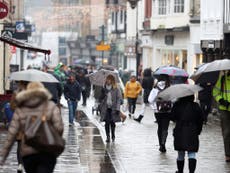We are witnessing the death of the high street – but here’s why we don’t need to be sad about it
Prior to the high street boom, local businesspeople tended to deliver to the door. Maybe now we are just reverting to type?
News that Philip Green’s Arcadia empire is safe from bankruptcy, but not without big job losses at its head office, has set off another bout of handwringing about British retail. A few more losses, the cries go, and the country’s high streets and shopping centres will resemble a scene from The Walking Dead: silent but for the feeding frenzy of the next closing down sale.
It’s a stark contrast to another vision of retail: where food gets delivered to your door in sustainable packaging, direct from local suppliers, while the cute new sweaters you wanted for the kids are made by a local artisan knitter. Except this isn’t an ad for modern day brands such as Farmdrop or Etsy – it’s what life was like on a council estate in South Shields in the early 1960s.
My parents grew up on the Whiteleas estate in South Tyneside, which my dad recently reminded me had no shops when first moved onto it. Only later were they to be serviced by the local grocers, owned by Mr Meeks then Mr Singh, and Betty’s, which opened on Christmas Day because poor Betty didn’t get on with her husband.
But before that there was the milkman, the grocer’s van, the fish van and a bloke from Rington’s who’d sell you tea and coconut snowballs. Meanwhile children’s knitwear could – if you didn’t stretch to Polly Flinders’ prices – be bought from various women who, if memory serves, thought of a knitting pattern as more of a rough guideline. My gran was the archetypal spoiled millennial: an enthusiastic participant in the on-demand economy who worked hard but could never afford to buy her own home.
This comparison might seem a little forced, but so is the prevailing view that British commercial life without a high street of familiar names may as well be a nuclear wasteland. There has always been more than one model for retailers to sell stuff. Some went door-to-door, others sold through the catalogues and press adverts. But between the 1960s and the early 2000s, retail became all about scale and efficiency meaning fewer, yet bigger shops.
The number of shops in the United Kingdom has been decreasing for at least a century. A study in the 1920s estimated that there were 950,000 shops in the so-called nation of shopkeepers; 583,000 in 1950 and just over 300,000 shops in the UK by 1997. By then these were highly efficient businesses. Self-service meant they needed fewer staff per shop, even if that meant they had to introduce measures like rigid plastic packaging to protect fragile goods.
They moved out of town because it was better for parking, stayed open longer and grew average shop takings from £5,000 per store in 1950 to £35,000 in 1997. At the same time the newspapers were full of think pieces lamenting the death of slower, service-led and home delivery businesses like the local milkman or the Grattan catalogue. The big shop’s dominance over our wallets and our discourse occluded other ways of reaching the customer, so we forgot them.
That was 20 years ago and the role internet giants like Amazon have played in dismantling this model of retail is well known. There is, however, another factor that we think about far less when talking about the demise of the high street: the Real Estate Investment Trust (REIT).
A financial instrument created in 1960, it allowed small investors to invest in commercial property via dedicated funds. It meant commercial property funds could pour billions into the shopping centres and out-of-town retail parks needed for big, efficient shopping. And it also meant they could extract billions more in rent from retailers.
Like all booms, the people involved convinced themselves it would go on forever, but of course it hasn’t. In January this year, figures from the British Retail Consortium and Springboard reported 10 per cent of all retail spaces in the UK were vacant and as long as retailers like Arcadia Group keep faltering this isn’t likely to improve.
Soon we might look back at the long property boom that turned shops into futuristic spaces in the same way that we do the opulent picture palaces of the 1920s and ‘30s. Their owners saw extravagance and scale as a way to make serious amounts of money, and then learned how expensive these spaces are to run when people start going elsewhere.
But where are they going? The internet, or maybe they’re not shopping at all. Whether it’s because of falling wages, fears over sustainability or people just feeling like they have too much stuff, the future of British retail looks smaller, more service-led and less reliant on shops.
We’ve come full circle on a trend that began in the 19th century, when shopping stopped being about the goods and started being about shops. Businesses like Hello Fresh or Farmdrop might feel like decadent nonsense to a generation used to doing a weekly shop in Asda, but another way of looking at them is a reversion to a time when shopping was what you bought not where you went. I’m sure my gran would have been scandalised by “recipe box” company Hello Fresh’s prices, but she’d also have understood the principle.





Join our commenting forum
Join thought-provoking conversations, follow other Independent readers and see their replies